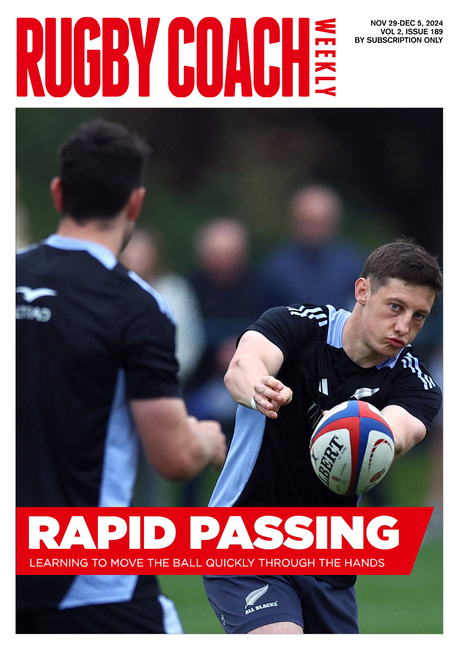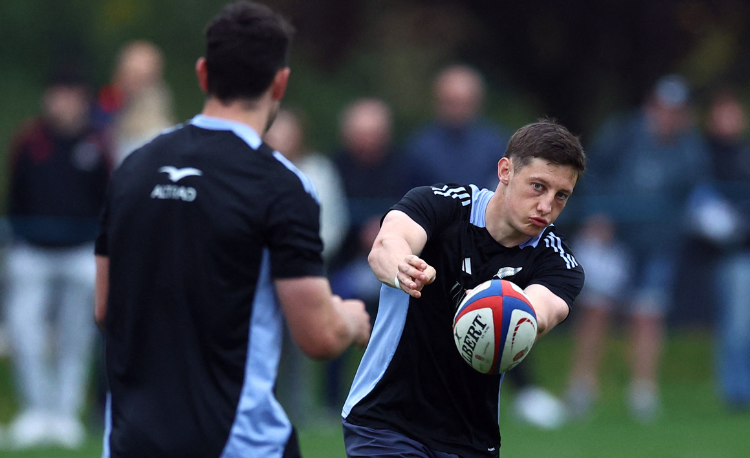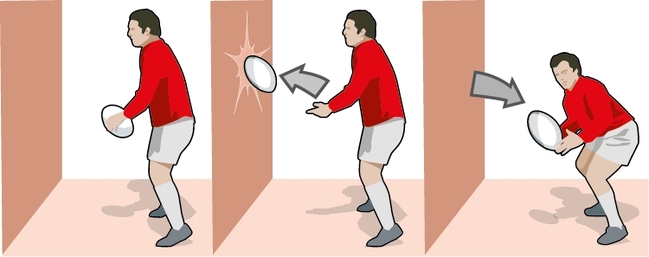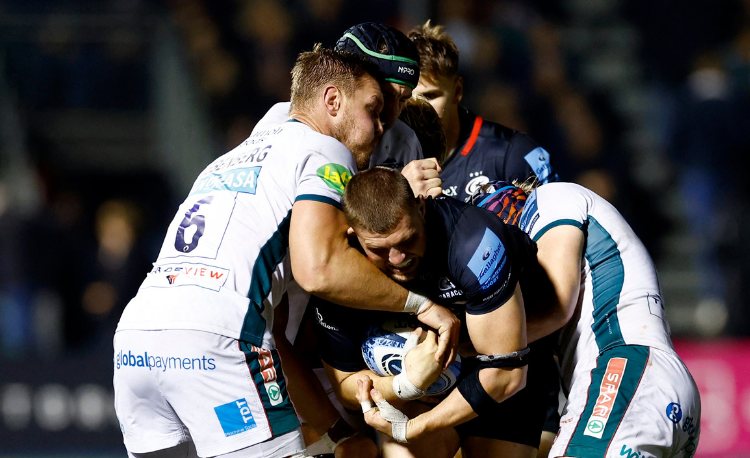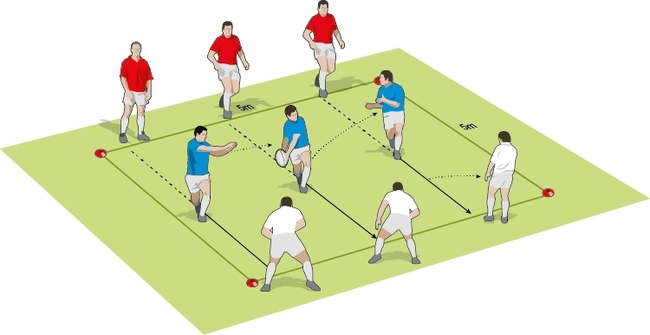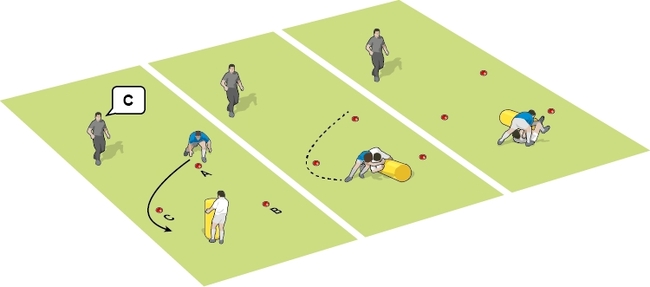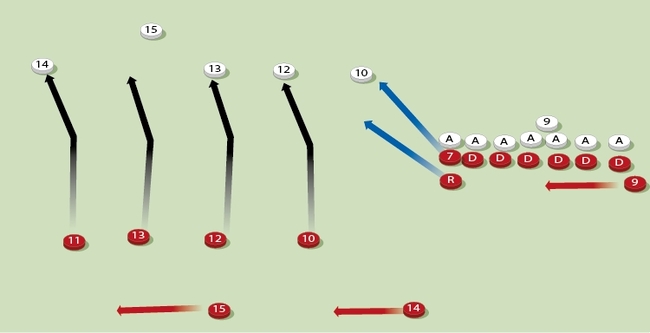Defence systems or heads up
Ruck defence is a hotly debated area, not least in terms of what systems work and if we actually need systems in the first place. With the help of Jamie Taylor, Leicester Tigers academy coach, I look at the range of options. By Dan Cottrell

Good ruck defence, that is the position of defenders in relation to the breakdown, prevents the attack making easy gains in ground. It aims to stop pick-and-goes by forwards, darting runs by the 9 or a short pass to a runner. Otherwise good execution by the attacking team allows them to be on the front foot for the next play, or ultimately score a try.
Decision-making around this area requires players to read the attack and react. In the first of short series on defence, we develop some theories around ruck systems.
1. Set defence for every ruck
You have a defined role for every player. This includes the order that players set up on arrival and their spacing. For example, a coach may prescribe that players say “far, near, far” or “far, far, near, near”, in relation to which side of the ruck to go to.
The roles of the players closest to the rucks tends to be similar, with the closest player to ruck stopping a pick and go, while the next player makes a run by the 9. The third and fourth players might be marking different players/spaces, depending on the system in place.
2. Reactive set defence
Jamie Taylor says a lot more sides run a reactive set defence.
If there’s a regular ruck speed of three seconds or more, that allows the defence to set up with three defenders either side taking up the positions outlined above.
This system flexes if there’s a quicker recycling situation. For example, if the attack manage to get significant momentum from a set piece. The defence might not have the time to set in the above positions
There are differences in the way that coaches expect which defender to set first, depending on speed of ball, space on the pitch and numbers of attackers.
For example, if the attack use a 12 to run at the back line from an “off-the-top” lineout ball, it is likely that defenders coming around the ruck will fill from third defender out, rather than guard (the closest defender to the ruck). They then put players into the space between the ruck and third defender.
Otherwise, the next arriving defender must run around the breakdown and around a defender who’s in the first position.
Floating guards
Also, you are seeing more teams using a floating “guard”. The guard is a common name used for the nearest defender at the ruck. If they see that the team need more numbers on the other side of the ruck, they will move over to the other side and pushing out the guard on that side.
Inactive guards
Decision making for guards doesn’t finish there. Once the ball has been released from the ruck, the guard who’s not on the side the ball has been passed is called the “inactive guard”. They need to decide whether to fold or hold.
A fold means they run to the other side of the breakdown and towards the ball. This is the most common reaction and certainly if there’s a line break, or the other guard is under pressure from a pick and drive.
A hold means the guard remains in that space. That means they are ready to defend should the ball come back the other way.
The importance of this is best illustrated when you see teams switch the play quickly. So, the main advantages for a holding guard are they don’t waste as much energy and maintain a line across the pitch.

Good ruck defence, that is the position of defenders in relation to the breakdown, prevents the attack making easy gains in ground. It aims to stop pick-and-goes by forwards, darting runs by the 9 or a short pass to a runner. Otherwise good execution by the attacking team allows them to be on the front foot for the next play, or ultimately score a try.
Decision-making around this area requires players to read the attack and react. In the first of short series on defence, we develop some theories around ruck systems.
1. Set defence for every ruck
You have a defined role for every player. This includes the order that players set up on arrival and their spacing. For example, a coach may prescribe that players say “far, near, far” or “far, far, near, near”, in relation to which side of the ruck to go to.
The roles of the players closest to the rucks tends to be similar, with the closest player to ruck stopping a pick and go, while the next player makes a run by the 9. The third and fourth players might be marking different players/spaces, depending on the system in place.
2. Reactive set defence
Jamie Taylor says a lot more sides run a reactive set defence.
If there’s a regular ruck speed of three seconds or more, that allows the defence to set up with three defenders either side taking up the positions outlined above.
This system flexes if there’s a quicker recycling situation. For example, if the attack manage to get significant momentum from a set piece. The defence might not have the time to set in the above positions
There are differences in the way that coaches expect which defender to set first, depending on speed of ball, space on the pitch and numbers of attackers.
For example, if the attack use a 12 to run at the back line from an “off-the-top” lineout ball, it is likely that defenders coming around the ruck will fill from third defender out, rather than guard (the closest defender to the ruck). They then put players into the space between the ruck and third defender.
Otherwise, the next arriving defender must run around the breakdown and around a defender who’s in the first position.
Floating guards
Also, you are seeing more teams using a floating “guard”. The guard is a common name used for the nearest defender at the ruck. If they see that the team need more numbers on the other side of the ruck, they will move over to the other side and pushing out the guard on that side.
Inactive guards
Decision making for guards doesn’t finish there. Once the ball has been released from the ruck, the guard who’s not on the side the ball has been passed is called the “inactive guard”. They need to decide whether to fold or hold.
A fold means they run to the other side of the breakdown and towards the ball. This is the most common reaction and certainly if there’s a line break, or the other guard is under pressure from a pick and drive.
A hold means the guard remains in that space. That means they are ready to defend should the ball come back the other way.
The importance of this is best illustrated when you see teams switch the play quickly. So, the main advantages for a holding guard are they don’t waste as much energy and maintain a line across the pitch.
Related Files
Vol-1-Issue-542-D-Cottrell-defence-systems-or-heads-up.pdfPDF, 740 KB
Newsletter Sign Up
Coaches Testimonials

Gerald Kearney, Downtown Las Vegas Soccer Club

Paul Butler, Florida, USA

Rick Shields, Springboro, USA

Tony Green, Pierrefonds Titans, Quebec, Canada
Subscribe Today
Be a more effective, more successful rugby coach
In a recent survey 89% of subscribers said Rugby Coach Weekly makes them more confident, 91% said Rugby Coach Weekly makes them a more effective coach and 93% said Rugby Coach Weekly makes them more inspired.
Get Weekly Inspiration
All the latest techniques and approaches
Rugby Coach Weekly offers proven and easy to use rugby drills, coaching sessions, practice plans, small-sided games, warm-ups, training tips and advice.
We've been at the cutting edge of rugby coaching since we launched in 2005, creating resources for the grassroots youth coach, following best practice from around the world and insights from the professional game.


